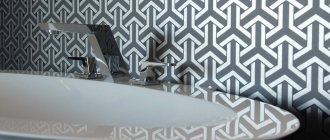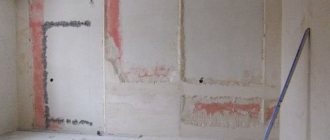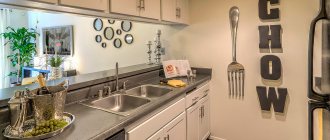A gas boiler in the kitchen is the best choice for heating the room. This system has a number of advantages and disadvantages, and is very popular among consumers. A gas boiler takes up quite a lot of space, and owners try to hide the massive device in closets, building niches, or behind improvised shelves.
Photos of the boiler in the kitchen, in various interior variations, can be found on the pages of practical design magazines.
Brief overview of the article
Advantages of choosing a gas boiler
With optimal installation and maintenance during operation, boiler owners receive a number of benefits:
- Reliable operation of the device and a long service life.
- Excellent for rooms with large square footage.
- Thanks to the reliable pipe system, there is virtually no heat loss.
Another advantage is a large assortment of devices with different shapes, sizes, and design features. The design of kitchens with a boiler can vary widely, depending on the chosen appliance model.
Materials
In order to mount a plasterboard box yourself, you will need the following materials:
- sheets of plasterboard, it is desirable that the material is resistant to moisture;
- vertical aluminum profile;
- self-tapping screws;
The following tools will need to be purchased or rented:
- electric screwdriver;
- metal scissors.
The procedure for making a plasterboard box
The progress of work will be as follows:
Then the metal frame is covered with plasterboard using the same self-tapping screws.
At the first stage, it is very important to correctly assess the size of the future false cabinet and plan its location. Where necessary, install a frame of profiles, securely attaching them to the wall with self-tapping screws
Such “skeletal” structures are located along the entire pipe
For greater structural strength, the elements located in a U-shape are fastened again to each other with scraps of metal profiles. After the metal frame is ready, we move on to working with drywall. First, you need to carefully measure and record all the distances between the profiles, then draw blanks of the appropriate size on the plasterboard sheets and cut them out. The final stage is finishing the resulting box. Gaps, unevenness, cracks and other existing defects are eliminated with polyurethane foam. The excess must be cut off.
The surface is leveled with primer and putty, special attention is paid to the joints. You can bring the box to absolute smoothness using sandpaper. Decorating the entire structure can be done in different ways, in accordance with the general concept of the kitchen interior:
Decorating the entire structure can be done in different ways, in accordance with the general concept of the kitchen interior:
- coloring;
- wallpapering;
- laying ceramic tiles, etc.
The undeniable advantages of this method of masking gas pipes include:
- simplicity of box design;
- cheap materials;
- aesthetics of the final design.
However, there are also disadvantages:
- reducing usable space in the kitchen;
- dismantling of the structure in case of repair or change of communications;
- a blind box would be a violation of safety regulations.
Other original ways to disguise gas pipes
Designers advise owners of kitchens in the newfangled hi-tech, techno, and minimalist styles not to hide the pipes, but, on the contrary, to emphasize them in any way - highlight them with color, shine, chrome, etc. Such a deliberate emphasis on technical elements is a key requirement when designing such functional modern styles.
For those who still can’t wait to hide the gasification system, we advise you to pay attention to these unusual methods of camouflage:
The situation when the gas tap is installed at a small height from the floor (up to 1 m) is not uncommon. It is very easy to disguise such pipes - hide them under the countertop. The ability to manipulate the gas valve is ensured thanks to the remote handle.
Two holes are made in the tabletop - one for the gas pipe, the other for the outlet of the tube, which is attached to the valve. A handle is attached to this tube from the outside, which regulates the termination of gas access if necessary. This method allows for maximum use of kitchen space and meets safety requirements.
A rather aesthetic and original option for decorating a gas pipe passing over the entire work area is to disguise it as a roof rail. In this case, the gas pipe is used as part of a system on which various kitchen accessories are located.
The pipe is cleaned to a shine, and then covered with chrome paint, preferably in several layers. Next, all kinds of hooks for napkins, shelves, baskets, holders for dishes, pendants, etc. are placed above the pipe; fortunately, the range for railing systems today is quite large. Of course, it is impossible to hang heavy structures on a pipe, so they are often attached somewhere very close to the pipe to create the appearance of a solid system. The result is functional and tasteful.
Finally, there are simply a lot of options for decorating, painting, and gluing gas pipes. Starting from simple decoration with pebbles, shells, rhinestones, and ending with the creation of entire trees, the trunk of which is a gas pipe.
Now you know different ways to decorate a gas pipe in the kitchen - from a standard plasterboard box to original, original solutions. Which one is suitable for your kitchen is up to you to decide.
Disadvantages of choosing a gas boiler
For such a device, a permit for installation is required, and there are also a number of requirements that must be met. The boiler is quite massive and occupies a position on the wall, so hiding the device is not so easy.
If you choose a low-quality model or violate the operating rules, a soot stain will form on the ceiling and the underlying wall. There are a number of practical tips from experts on how best to install a gas boiler to avoid such situations.
The law is harsh...
Household gas is a source of increased danger, or rather an explosion hazard. Moreover, not only you and your home can suffer, but also your neighbors and the whole house. Therefore, everything related to gas is subject to strict regulation. For violating the rules there is a very serious fine.
SNiP 42-01-2002 specifies technical requirements for the operation of a gas pipeline
What is important for us here:
- all gas equipment, including pipes, must be open and accessible for inspection;
- it is not allowed to close the pipeline hermetically;
- various structures covering the gas pipeline must be easily removable and not impede air circulation. There should be no load on the pipe, i.e. You can't attach anything to it.
Boiler installation rules
The main principles that must be observed when using heating devices are safety and quality. To fully comply with these principles, it is necessary to correctly install the structure.
Requirements and rules for installing the boiler:
- Use non-residential premises for location.
- Be sure to provide an entrance door to the room with the boiler.
- There should be vents on window openings. High-quality air circulation in the room is the key to optimal functioning of the device and the safety of residents.
- Take into account the power of the gas appliance, which should not exceed 60 kilowatts.
- The underlying wall should be made of non-combustible materials, and it is better to cover the wood parts with a sheet of metal.
- Free space should be left between the gas appliance and the walls of the unit, refrigerator and other electrical appliances.
For safety reasons, it is better to first check the permeability of the chimney, the state of draft and the quality of operation of the device itself.
Instructions for locating the boiler according to the standards can be found on the official website of any regional gas supply office.
Location Features
When developing a kitchen design, you should seriously consider how a new heating device will fit into it.
It is quite possible to choose a unit that matches the color of the kitchen set or household appliances. In this case, the gas boiler will organically fit into the overall style. It can be installed between kitchen cabinets. This technique is allowed not only by heating device manufacturers, but also by gas and fire services. Installation diagram of a parapet type gas boiler.
When installing an appliance in this way, you should think not only about how it will fit into the kitchen design, but also about the standards provided for installation. According to the standards, in order to ensure adequate ventilation, there must be at least 3 cm of free space on each side of the boiler. In addition, to protect cabinets located nearby, their side walls will need to be covered with non-combustible materials.
If you are not yet planning to purchase new heating devices, then it is quite possible to update the old ones and give them a more modern look. The front panel of the device must be thoroughly cleaned and sanded. Then the surface is coated with a metal primer. After it has dried, the boiler can be painted with heat-resistant enamel for metal surfaces. The color of the enamel should match the color of the kitchen furniture. If you want to get something exclusive and not like an ordinary household appliance, then using special stencils you can paint a gas boiler with a variety of patterns.
Interesting ways to cover a boiler
The following boiler location options will look interesting in the interior of a modern kitchen:
- Original box made of chipboard panels.
- Shelter in a construction niche.
- Decorating the outer wall of a gas boiler.
- Use of decorative grilles.
There are a lot of ideas on how to hide a boiler in the kitchen. The choice of decoration method depends on many factors: the size of the kitchen area, the location of the set and other furniture, the style of the interior and the artistic skills of the apartment owner.
We need to hide communications
In addition to the heating devices themselves, the overall design of the kitchen can be spoiled by their communications: pipes, chimneys, hoses, taps, which are used during installation and ensure the operation of the units. According to current regulations, there must be free access to them during operation. Therefore, you cannot hide them in the wall.
However, many manufacturers help owners of heating devices solve the problem of how to hide communications without disturbing the design of their kitchen. Complete with heating devices, you can purchase various panels and boxes with which you can easily cover pipes and hoses and, if necessary, easily remove them.
Using drywall or plywood, the owner can make the desired box himself. To do this, you need to cut out the parts of the side and front walls of suitable sizes and connect them together. The finished structure is placed against the wall. It can be secured using self-tapping screws. In order for the overall design of the room to be preserved, the box must be painted in the color of the furniture or household appliances, or it can be finished with the same material that was used for finishing the walls.
Heat supply systems for private houses With the development of low-rise construction, the demand for equipment necessary for the installation of heat supply systems for individual residential buildings has increased significantly.
Responding to demand, the modern Russian market offers such a number of domestic and imported boilers using various types of energy carriers
. that in order to select the optimal model, you must have at least basic knowledge of the principles of the heating system.
Decorating the outer wall
If you wish and have the proper artistic skills, you can paint the front wall of the device directly. You can use stencils in your work or create plot compositions from your own sketches.
The most important principle is mandatory preliminary consultation with a gas equipment specialist. Failure to comply with these rules can result in a significant fine.
Technology and stages of operations performed
Work on moving gas supply pipelines does not take much time and labor resources. Dismantling and installation of one pipe takes one hour of working time for a team of welders and installers consisting of two people. Moving a gas pipe in the kitchen by one worker is strictly prohibited.
Preparatory activities
Owners of an apartment or private house are not recommended to change anything in their gas system, not even flexible hoses. The transfer, extension, and cutting of pipes has the right to be carried out exclusively by a representative of the gas service with the appropriate permit. However, it would be useful for people using gas equipment to know some of the provisions and sequence of actions when carrying out gas pipes.
Most often, a specific moving team consists of two people. Both specialists are trained in all operations, have a certificate for working with gas equipment, and professionally carry out welding and metal cutting. The craftsmen begin work on site within one calendar week after agreeing on the technical documentation for moving pipelines.
At the time of the team’s visit, the points for dismantling, extending, and installing additional gas equipment are already known. Gas water heaters, stoves, ovens, and heating elements are subject to modification. The craftsmen are perfectly familiar with the rules for performing installation operations. According to regulations, it is not recommended to cut off valves blocking the gas supply. They are mandatory components of the gas transportation system.
Preparatory activities before moving the gas pipe
In addition, according to the rules for using gas as a fuel, when moving the points of the pipeline, as well as changing the gas valve, a specialist must install it in such a way that the valve is located in an area of direct access for the user. The valve installed under the countertop requires easy access through a cabinet door with the back wall removed. Sometimes access is through a piece of countertop that opens.
Taking this opportunity, the apartment owner can install a gas control meter. You can also replace any outdated kitchen equipment. The team that is moving the gas pipe to another location should be warned in advance about these operations. When connecting ovens, stoves, speakers, the owner of the apartment is obliged to buy a bellows hose in advance, selected according to the size.
Invited workers purchase metal pipelines themselves. The cost of pipelines is included in the total estimate of services, materials and equipment. The owner needs to clear the kitchen space of furniture and bulky items. This way, specialists will carry out the entire complex of installation on your gas pipeline faster and with better quality. Things that cannot be taken out must be covered with non-flammable dense materials.
Pipeline dismantling
Most likely, when moving, you will need to cut out a section of the old pipeline and extend it onto a new one, only in the opposite direction. In this case, a specialist, using special devices, cuts out unnecessary elements. Here, the qualifications of the worker who has permission to move gas pipes plays a huge role.
Electric welders, gas cutters, mechanics are trained in special courses, where they are certified by professional gas equipment workers. After passing serious exams, they are given a special document. Having dismantled the branch leading from the riser to the device, the master leaves a section of the pipeline. A liquefied gas shut-off valve is installed on it.
This section of horizontal pipe must not be changed or removed under any circumstances! There can only be one situation - an accident with damage to the pipeline. If it is impossible to do without a complete replacement, then it is permitted. Often in practice, residents of the upper floors of apartment buildings ask to cut off a long piece of pipeline.
This element rises from the lowest point of the apartment to the highest point to a height of 1.8 m, then bends at an angle of 180°. It is prohibited to shorten such a pipeline by installing a valve on the remaining piece. But there is a solution for this situation - it is necessary to weld the pipeline and place the valve at a height of 75 cm from the floor under the countertop.
Photo of boilers in the kitchen
Note!
Blinds for the kitchen made of wood, plastic, aluminum and fabric: photo review, description of types and tips for choosingKitchen in light colors - overview of interiors in loft, hi-tech, minimalism and Scandinavian styles (photo + video)
Photo wallpaper for a children's room: rules for choosing, recommendations for combination, photo and video tips for a boy's and girl's room
Looking for a place
The operating rules for gas appliances allow their installation next to furniture modules. But for normal operation of the equipment without overheating, ventilation gaps on the sides of the boiler must be maintained at least 30 mm. The cabinets themselves must be reliably protected from high temperatures by linings or shielding heat-resistant compounds.
Sometimes it is easier to hide a flow column in the interior behind a curtain wall. But you need to follow the rules when manufacturing the casing of the masking module:
- it should be 6 cm wider than the unit;
- The presence of top and bottom covers, as well as a back wall, is not allowed.
That is, you should simply order a large frame with a door, behind which there will be a well-ventilated column. This method is not always suitable for small kitchens - too much free space is stolen by a box made according to all the rules.
Another solution is to mount it above a corner sink. Wall cabinets will be located on adjacent walls, covering the heater from view with their housings. A floor-standing boiler will fit better into the interior if it is the last one in the bottom row of furniture. This way, it’s easier to direct the chimney outside, and the heating device won’t be conspicuous. Do not forget about the distance from the heaters to the gas meter: it should be at least 1.5 m.
Ideally, your kitchen initially has a column or niche formed by a protruding ventilation shaft, as in this photo. Then the boiler can be hidden in a free corner and the chimney connected here.
Redevelopment
Typically, kitchens occupy a small area with maximum load. Placing additional furniture is not always possible. Installing equipment with its communications clearly will not add comfort.
Try to arrange the furniture to hide it as much as possible. This is not possible - use existing wall cabinets and convert them to accommodate its installation. You can easily complete this task yourself.
Thinking through the design
Modern kitchen design with a gas boiler on the wall can be of different types. Let's look at the two main types in more detail in the table.
| View | Techniques | Peculiarities |
| 1. Open: | decoupage, pasting, painting, painting. | Provides for the selection of equipment as an original element of the interior. It is covered with photographs, painted in original ways with special safe paints, and decorated with mosaics. These techniques are great for Provence and country styles. |
| 2. Closed: | camouflage using plasterboard construction, furniture. | In this case, the gas boiler is masked as much as possible from others. The difficulty of this type is compliance with safety precautions. Materials must be non-flammable and air must circulate freely. Floor equipment is masked with a pencil case. It will protect children from injury and will not contradict the main stylistic direction of the kitchen. |
To completely hide the boiler, you can purchase a custom-made set
Be sure to follow safety rules
Modern kitchen design with a gas boiler on the wall can be of different types











